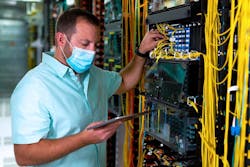>> Electronic Design Resources
.. >> Digital Editions
.. .. >> Top Stories of the Week
.. .. .. >> 2021 Electronic Design Forecasts
What you’ll learn:
- How to train AI models in a power-efficient manner.
- What foundations need to be in place for 5G to revolutionize our world.
- Why the industry will focus on Level2/2+ ADAS.
In 2020, the world quickly adapted to a new normal and technology evolved with the changing landscape. Some of the most exciting developments from the last year, including contactless experiences, 5G phones, and remote work-friendly digital infrastructure, were made possible with memory and storage at the core.
With a new year ahead and insights from last year behind us, here are some of the trends from 5G, artificial intelligence (AI), and automotive that we anticipate will grow in 2021 and beyond. And it’s expected that these shifts will fuel radical changes in memory and storage, and vice versa.
AI Turns the Heat Up on Memory and Energy
AI will become more accurate and more ubiquitous. We'll start to see it filling in more gaps for simple tasks where people would have traditionally said, "Why would I ever use an AI algorithm for that?" For example, grocery stores might tap AI-enabled cameras that periodically check to see if a shelf is empty, and if so, alert a clerk to restock. In a post-COVID world, we’ll see more businesses adopting AI for use cases like these to create these contactless experiences. We’ll also see AI moving into infrastructure such as data centers and 5G base stations as neural-network algorithms become more adept at workload and system error correction and recovery.
You’ll have AI algorithms for simple, singular tasks and sophisticated algorithms for mapping the human brain. AI with such agility requires a significant amount of memory bandwidth, and when you add memory bandwidth, you’re adding power—researchers have found that training a single AI model can emit 5X the lifetime carbon emissions of an American car (including manufacture).
These immense power requirements aren’t sustainable if AI is to be pervasive in our society both in terms of the data center and our planet. In the next several years, we’ll see ecosystem players exploring new ways of powering AI in an energy-efficient manner. That could be taking AI architecture and moving it closer to the memory via stacking memory in a 3D package on top of the logic.
Beyond the hardware, today there's lots of bandwidth—and data—we're leaving on the table, meaning huge amounts of energy wasted. So, in the years ahead, we may see a rise in technologists analyzing how to fine-tune AI algorithms to get as high performance as possible, but with extremely stingy power levels.
5G Takes Flight in a Brave New Socially Distanced World
We’ll see near-term benefits in mobile, especially with the deployment of 5G networks this year, which will accelerate globally. In fact, global 5G mobile-phone shipments are expected to double to nearly 500 million units sold. These fast speeds and low latencies will enable people to truly multitask with their phones. Consumers will be able to stream a high-definition multiplayer video game to their television while simultaneously video chatting, texting, and doing work on their phone.
With all of these rich, data-heavy mobile needs, there will be increased demand for high-bandwidth, low-power memory such as LPDDR5, which will be critical for keeping pace with compute-intensive behaviors without draining battery. With order-of-magnitude higher 5G download speeds, which in turn enables users to download multiple 4K episodes of their favorite TV shows and movies quickly, we also expect increased storage requirements in smartphones.
In the years to come, 5G will also begin to allow for new and improved telemedicine, tele-learning, and virtual entertainment. Already, the pandemic has forced us to embrace these, but it’s clear that the optimal infrastructure isn’t there. As 5G becomes a reality and the cultural shift toward social distancing lingers, we could see it enabling 4K/8K high-resolution video for telemedicine, personalized AI-based teachers in virtual classrooms, and lag-free Zoom meetings.
Given what we’re already seeing, in the future 5G could even power inventive, contactless experiences in retail and hospitality, as well as interactive sporting and entertainment experiences. Imagine immersive, 360-degree, virtual experiences for arena sports such as football, all enabled by multiple cameras shooting the same scene from different angles. A smartphone would then process together these feeds to create a real time 360-degree view, allowing viewers to watch the game from different angles in real time.
That being said, the promise that 5G will revolutionize our lives immediately or even by the end of this year is overhyped. It will take time for disruptive use cases to develop, maybe three to five years. First and foremost, the foundational 5G infrastructure, memory, and storage needs to be in place—then those disruptive applications will follow.
Autonomous Brakes, ADAS Accelerates
In this pandemic environment, we’ll see a slowing of the timeline toward fully autonomous-vehicle deployments as automakers prioritize their investments, and ridesharing companies pull back on fleet expansion. This, of course, will reduce the dollars, miles, and data needed to advance the technology toward Level 4/5 autonomy in the near-term. COVID put a damper on the aggressive adoption we might see otherwise in the autonomous space; people are hesitant about public transportation and ridesharing.
However, the market’s fundamental growth drivers remain intact, especially as consumers increasingly shop for vehicles more like smartphones, weighing up digital features like personalization, and UX, rather than horsepower and make. We’ll see a rise in enriched features, including enhanced connectivity, larger digital displays, and full digitalization of the cabin, with these serving as key purchase differentiators for consumers.
The industry will exert a renewed focus on improving the effectiveness, safety, and driver experience of Level2/2+ ADAS features, driving growth in adaptive cruise control, automatic emergency braking, lane keeping/changing, driver monitoring systems, and C-V2X vehicle-to-vehicle communications. These efforts will in tandem help the industry make strides toward fully autonomous in the long-term.
When we reach that juncture, we believe that autonomous vehicles are going to make it into the enterprise first, such as robo-taxis via mobility-as-a-service providers as well as trucking and delivery solutions. These areas can afford the costs of fully autonomous and reap enough ROI for the economics to make sense.
The full benefit of autonomous factories is yet to be realized, but a trend toward micro-factories will accelerate in 2021. Most factories today are still based on the more than 100-year-old Henry Ford principle of massive scale and centralization. While the concept of distributed, agile, smaller, digital-first factories closer to end markets has been around for years, the pandemic and the need for some onshoring are catalysts that will speed this transition. These micro-factories will be built on the foundation of industrial IoT (IIoT) and automation, enabling them to be nimbler and, thus, more responsive to demand closer the source.
This trend of intelligence-at-the-edge will also propel demand for edge-to-cloud platforms to manage, connect, and secure smart devices, factories, and infrastructure. While many are early in the deployment of IIoT solutions, the full benefit of data analytics in smart factories has yet to be realized. The shift to more automated manufacturing will accelerate the advances and adoption of data technologies, enabling smart insights at the industrial edge.
While no one truly has a crystal ball into the future, we expect 2021 to bring exciting advances from edge to cloud across AI, 5G, and IIoT. Those who will thrive in this evolving landscape are those who can leverage next-generation memory and storage to adapt to the times and propel innovation across the cloud to consumer devices to the intelligent edge.



